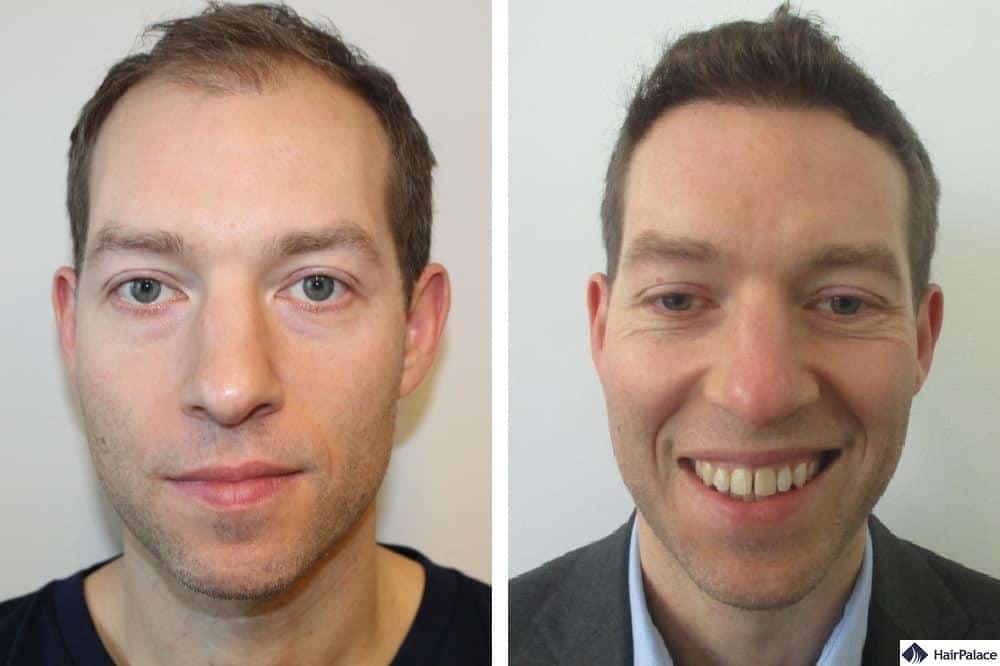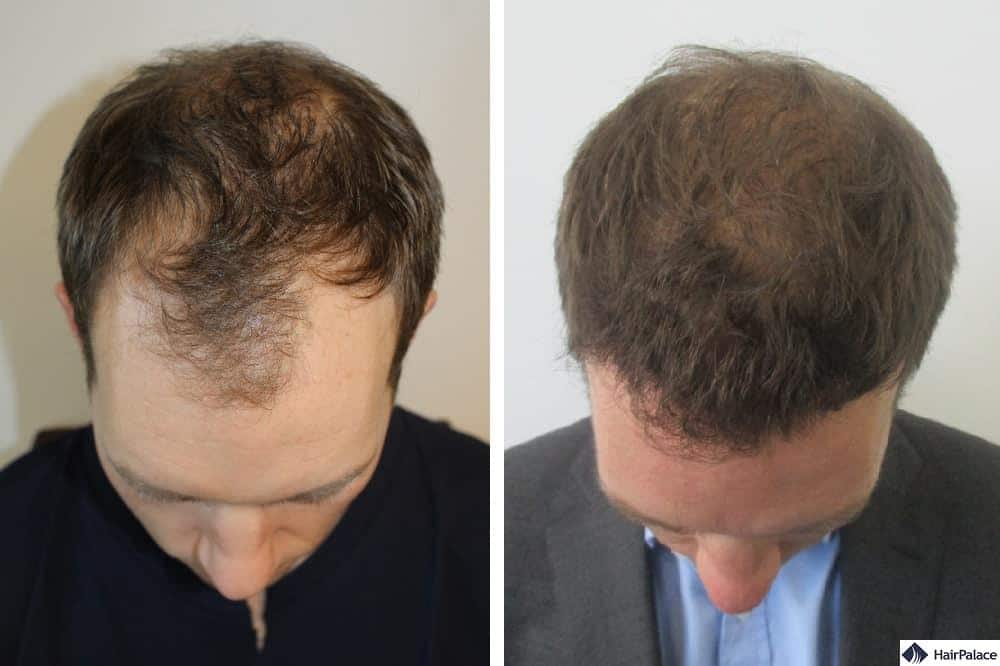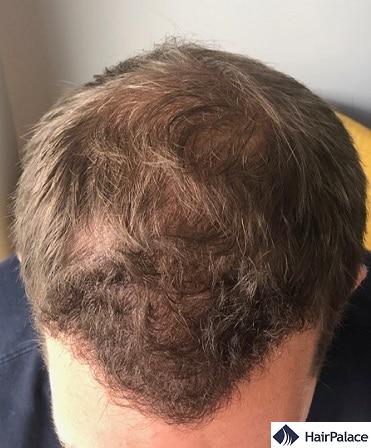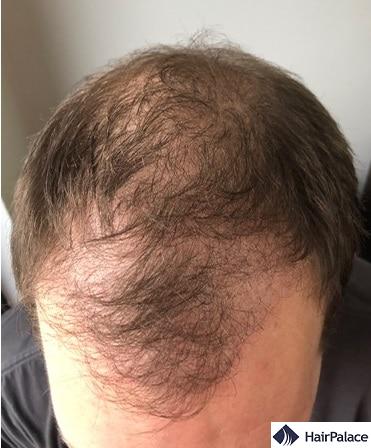Amazing Change with 6000 Hairs – Toby’s Hair Transplant
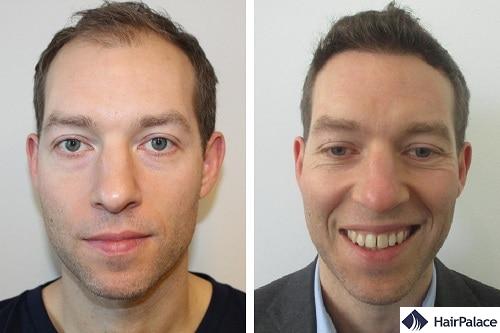
Right after the procedure, it is evident if someone had a hair transplant done, but the result isn’t visible immediately.
Patients have to wait for months to see the full effect and experience a gradual change.
Toby from Birmingham had his procedure here at HairPalace in December 2018, so the transplanted hairs are fully grown by now.
In today’s post, we will take a look at the full process through his example.
The examination
Toby met us for a consultation on the 14th of August 2018.
The main area of his concern was the front – his hairline receded at the temples, and he lost density in the mid-front too:
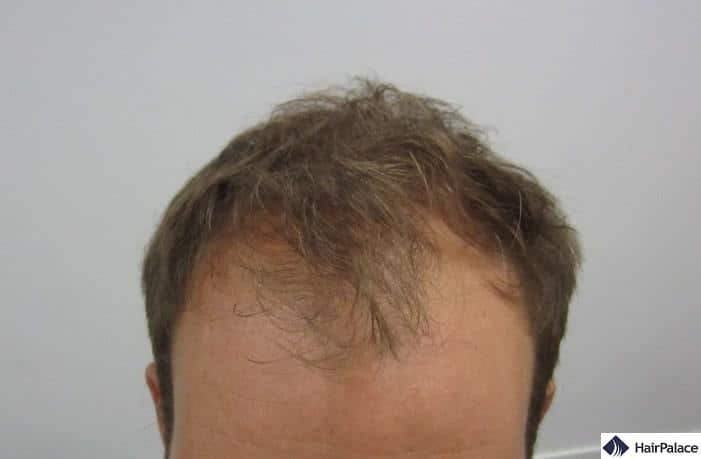
His crown started to thin, but it didn’t allow the implantation of a significant number of hairs.
The doctor affirmed that his donor area is suitable for the extraction.
We recommended Toby 5-6000 hairs – with this amount we could build out the hairline he was looking for, and we could also have a smaller number to implant to the crown.
The FUE2 surgery
We carried out Toby’s hair transplant with the FUE2 SafeSystem on the 14-15th of December 2018.
In total 6386 hairs were transplanted; we implanted 5886 hairs to the front and 500 hairs to the crown as planned.
The surgery day has two distinct parts. After numbing the donor area, we extract the hairs one by one. The FUE2’s blunt drill helps us to ensure that we do not cut or harm the roots.
After the lunch break, we move on to the implantation. First, we finalize the recipient area; then we administer the lidocaine injections and start implanting the hairs.
Transplanting 6300 hairs takes two days, with 6-8 hours of procedure on each day.
The check-ups
The freshly transplanted hairs are sensitive; and while patients return home after the surgery, they have to follow strict aftercare instructions.
To ensure that everything goes well and the patients achieve the expected results, we monitor the progress.
We have six check-ups throughout the post-op period: we assess the condition at 1, 2, and 3 weeks, and then 3, 6, and 12 months after the surgery.
Patients can attend the check-ups in person if we have consultations in the appropriate time. The other option is to send us photos.
Naturally, we are available beyond the mandatory check-ups; patients can easily reach us anytime if they have questions or concerns.
2 days after the surgery
Just 48 hours after the hair transplant, the recipient area is clearly defined.
On the photo below, we can also see a bit of swelling around the eyes:
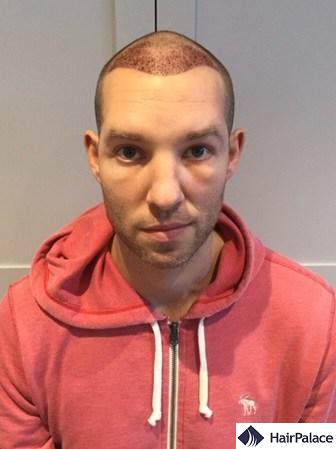
During the surgery, we use lidocaine injections to numb the scalp and carry out the procedure pain-free.
Due to the gravity, the lidocaine will move downward – swelling up the forehead and then potentially the eye area in the first few days after the surgery.
While it is harmless and disappears on its own, it can understandably cause discomfort.
We advise patients to increase the water intake and frequently massage the forehead to minimize the swelling. If needed, steroid tablets can also be taken to prevent the swelling.
7 days after the surgery
A week after the hair transplant patients have to start soaking off the scabs in clean tap water.
The thorough soak and the gentle massage must be repeated daily, so the scabs disappear gradually.
On the photo below, we can see that Toby has done the first wash already. Compared to the photo taken 2 days post-op, the scalp is much cleaner, and there is no trace of swelling:
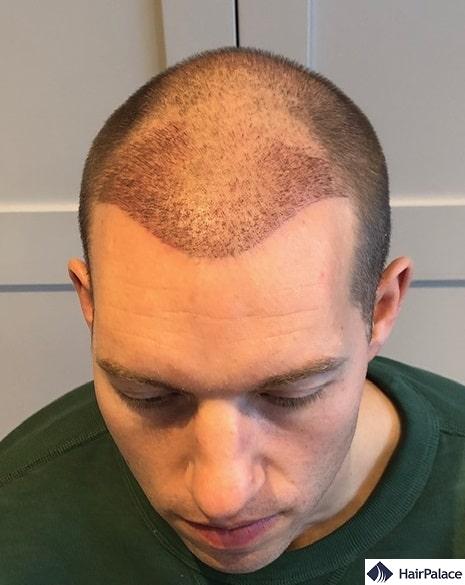
21 days after the surgery
By the end of the 3rd week, the scalp is free of scabs.
As we can see on Toby’s picture, redness might be visible too – with sensitive skin, it can take a few weeks to completely fade away.
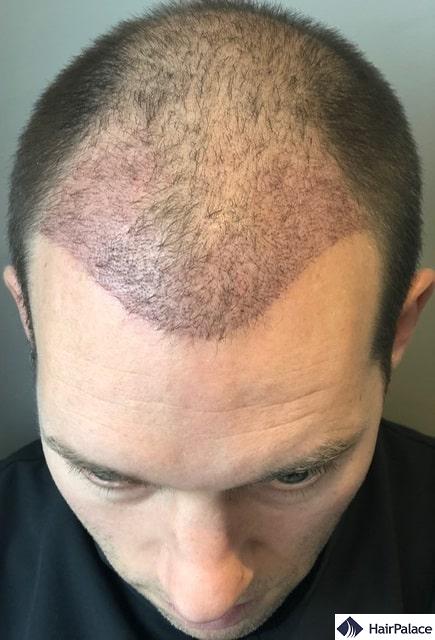
Here and there, we can also see a few hairs missing.
At this point in the progress, this is perfectly normal: the hairs start to fall out around the end of the 3rd post-op week.
3 and 6 months after the surgery
The transplanted hairs fall out by the end of the 3rd post-op month.
The roots enter a dormant period before they start growing new hairs. As this process happens gradually, we can usually detect the first growth in the recipient area at the check-up.
The progress heavily depends on individual qualities. Thus seeing a bit more hairs, or no growth at all at the 3-month mark does not indicate a problem.
The new hairs start growing remarkably around the 4th post-op month; we evaluate the improvement at the 6-month mark.
By his 6 months’ check-up, Toby experienced excellent regrowth already.
Take a look at how much his hairline and front changed in the 3 months between his check-ups:
1 year after the surgery
After the surgery, it takes 12-15 months for all the transplanted hairs to grow out.
Again, there are individual differences, but at the last check-up, we usually see the final result.
For his 1-year check-up, Toby contacted us on the 25th of February 2020.
At the examination, we learned that Toby is pleased with the result. We could also affirm that the hairs have grown in the expected number, providing optimal density at the front.
Below you can take a look at the change Toby went through with his hair transplant:
